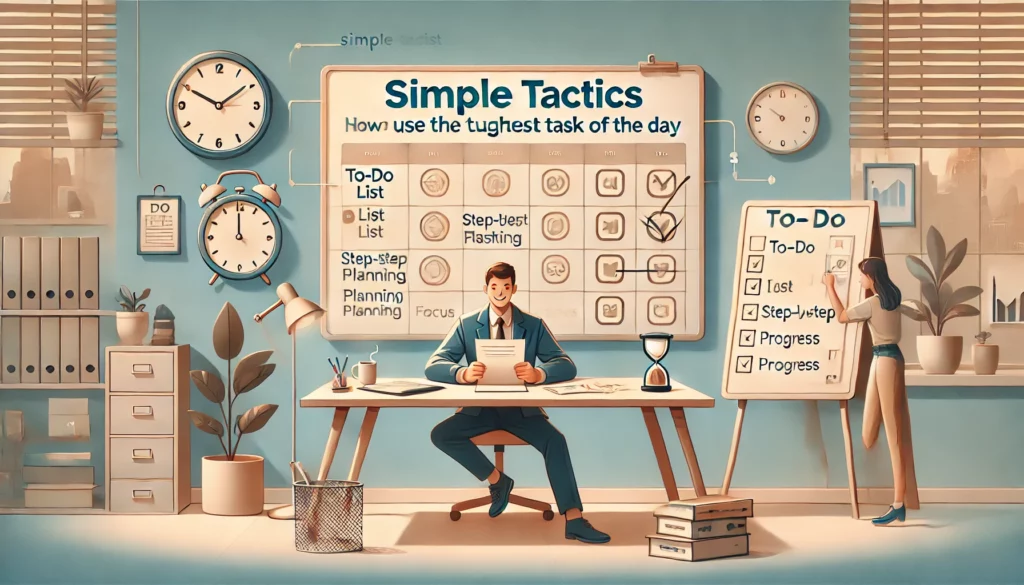There’s always that one task you keep putting off.
Maybe it’s a complicated work project, a phone call you’ve been dreading, or just something that feels too big to face first thing in the morning. Instead of tackling it head-on, you find yourself checking emails, organizing your desk, or doing anything else that feels easier.
And while those small tasks might give you a false sense of productivity, the real problem—the task you’re avoiding—remains. It lingers in the back of your mind, draining energy and increasing stress with every hour that passes.
But what if you could handle that difficult task without all the hesitation and resistance?
In this article, you’ll discover practical, easy-to-apply tactics to help you tackle your toughest task of the day—so you can stop procrastinating and start feeling in control again.
Why It Pays to Start with the Hardest Task
When something feels uncomfortable or demanding, your brain naturally wants to avoid it. But delaying the hard stuff often creates more stress than the task itself.
Here’s what happens when you handle it early instead:
- You stop the mental cycle of “I need to do this” that runs on loop all day.
- You feel productive right away, which builds momentum.
- You create more mental space for creativity and focus later on.
- You avoid last-minute panic or rushed results.
Many successful people use the “Eat the Frog” method, popularized by Brian Tracy. The idea is simple: if you had to eat a frog today, do it first thing. Otherwise, you’ll spend your day dreading it.
Let’s look at how you can start applying that mindset—without the frog.
1. Use the 5-Minute Rule to Just Get Started
Big tasks feel overwhelming because we picture the entire mountain. But starting is always the hardest part. To beat that mental block, give yourself permission to work on the task for just five minutes.
That’s it—just five.
Once you’re in motion, it’s much easier to keep going. It’s like tricking your brain into skipping the resistance phase.
Try this:
- Set a timer for 5 minutes.
- Open the document, make the call, or take the first small step.
- Don’t worry about finishing—just start.
Example: Need to write a proposal? Open the file and type the title. Then, write the first sentence. You’re already further than before.
2. Tackle It When Your Energy Is at Its Peak
Every person has natural energy highs and lows during the day. For most people, the morning is when the brain is sharpest. Use that time for the hardest thing on your list.
Don’t waste your best focus on emails or admin work. Save that for later.
How to apply it:
- Schedule your most demanding task in your “peak zone” (often the first 1–3 hours of your workday).
- Block off this time for focused, distraction-free work.
- Avoid meetings, calls, and interruptions during this window.
Example: If your brain is sharpest between 8:30 AM and 10:00 AM, don’t check emails right away. Dive into your most difficult project first.
3. Break It Down into Small, Clear Steps
We often procrastinate because a task feels too vague or too large. Instead of seeing it as one big, scary thing, turn it into smaller, more manageable parts.
You’ll trick your brain into seeing progress sooner—which keeps motivation going.
How to apply it:
- Write down the task and break it into 3–5 actionable steps.
- Start with the easiest or most specific one.
- Celebrate small wins along the way.
Example: If your task is “Launch marketing campaign,” break it into:
- Draft email content
- Collect images and assets
- Schedule posts
- Set up automation
Then, just start with task one.
4. Try the “2-Minute or 10%” Trick
When your brain says, “I don’t feel like doing this,” respond with a compromise.
Tell yourself you only need to work for 2 minutes—or complete just 10% of the task. Often, once you start, you’ll want to keep going.
How to apply it:
- Set a small goal. “I’ll work on this for just two minutes.”
- Or choose a small fraction. “I’ll only read the first 5 pages.”
- Stop if you want—but chances are, you’ll keep going.
Example: If you’ve been avoiding organizing a report, tell yourself, “I’ll just create the file and format the first section.”
5. Make It Non-Negotiable by Scheduling It
When a task is floating around your to-do list without a specific time, it’s easier to ignore. But if it’s scheduled on your calendar, it becomes a commitment.
Decide in advance when you’ll do it—and make that time sacred.
How to apply it:
- Block out time on your calendar for the task.
- Treat it like a meeting with yourself.
- Remove optional thinking—when it’s time, you just do it.
Example: If your most avoided task is “write client pitch,” block out 9:00–10:00 AM and label it “client pitch writing session.” Then, show up for it like any important meeting.
6. Use Accountability to Increase Follow-Through
Sometimes it’s not enough to promise yourself—you need someone else to know about your goal.
Accountability can be incredibly motivating when procrastination kicks in.
How to apply it:
- Tell a friend, colleague, or coach what you plan to do and by when.
- Set up a check-in system (e.g., “I’ll send you a screenshot when it’s done”).
- Use tools like Focusmate, StickK, or public goals to stay accountable.
Example: Let a coworker know, “I’ll have the first draft done by noon—hold me to it!” You’ll be much more likely to follow through.
7. Reward Yourself After Completion
When your brain starts associating hard work with something positive, it becomes easier to take action in the future. Rewards reinforce behavior.
How to apply it:
- Choose something small but enjoyable—coffee, a break, a short walk.
- Only give yourself the reward after completing the task.
- Celebrate progress, not just perfection.
Example: If you finally send that intimidating email, treat yourself to a cozy break with your favorite playlist or a quick walk outside.
Final Thought: You Don’t Need to Feel Ready
The biggest productivity trap? Waiting to feel motivated.
Here’s the truth: you don’t need to be in the mood. You just need to begin.
By applying these simple tactics, you’ll start building a habit of doing what matters most—without all the stress and delay.
Let’s recap what happens when you tackle your toughest task first:
- You free up mental energy for the rest of your day
- You stop the cycle of guilt and avoidance
- You create momentum that spills into other areas of your life
Start today: Choose the hardest task on your list, set a 5-minute timer, and take the first step. You’ll be amazed at how good it feels to finally get it done.
Gabriel Silva is the founder of Cursos e Soluções, a blog dedicated to personal growth, habit change, and self-discipline. Passionate about self-development and productivity, he shares practical, research-backed strategies to help people achieve their goals. He believes that small, consistent changes can lead to significant transformations over time and is committed to providing content that empowers both personal and professional success.







